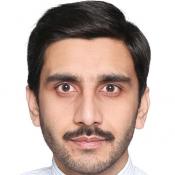Microwave seminar | 14 December 2020

Coding Metamaterials/Metasurfaces (MMs/MSs) are the digital version of the traditional MMs/MSs. The basic elements in these types of MSs are called digital coding unit cells or digital coding meta-atoms which can provide discrete phase and/or amplitude responses and can be mapped on binary numbers 0,1, 00,10, and so forth. Coding MSs which are combination of 0, 1, 01, 10 ……., digital codes can manipulate the EM waves through a pre-designed coding sequence and its emergence have eased the design procedure and offered new degrees of freedom to fully control and manipulate the electromagnetic (EM) waves. Most importantly the idea of digital coding MSs have bridged the physical and digital worlds, where information science can be processed on MSs. In this regard, many digital algorithms for example convolution operation can be performed on these metadevices. This presentation is aimed to discuss coding MSs with a special focus on bi-functional and multi-functional digital coding MSs.
In this talk I will discuss about various digital coding MS designs and its applications which are summarized as follows:
- A dual band 2-bit coding MS is proposed where independent manipulation of reflected EM waves can be performed in the two operating bands. Full structures are designed and simulated for various functionalities, which include beam steering of spatially propagating waves to opposite half planes in reflection geometry. The other tasks demonstrated are PW-SW conversion in lower band and beam steering of PW in higher band independently. The fabricated structures along with experiments are also demonstrated with very good measured results.
- Multiple vortex beams with distinct topological charges and deflected vortex beams are demonstrated in two different bands by taking advantage of dual band coding MS. Moreover, negative and retro reflections are also demonstrated in one band and specular or anomalous reflection in the other band at various oblique incidences. Experiments are performed for steered vortex beams and negative and retro reflection after fabricating two different meta devices.
- The unit cell of the dual band coding MS is further optimized and applied to generate distinct holograms in the two operating bands. Weighted Gerchberg Saxton algorithm is employed to project various phase only holograms in this frequency multiplexed structure. Two designs are fabricated for experimental verification where two letters or symbols completely different are projected from the same aperture. The demonstrated results are in excellent agreement with simulated results.
- A thin transmission type digital coding MS is proposed which can operate in dual band with the feature of switching the band of operation by tuning the incident linear polarization. Full structures with 1-bit and 2-bit resolution are designed simulated and fabricated for various functionalities including vortex beam carrying OAM with different topological charges, focusing, anomalous refraction and beam shaping. For experimental verification three different structures are fabricated and tested in various anechoic chambers for the applications of beam shaping, Vortex beam generation and focusing. All the experimental results in both operating bands (Ku) and (Ka) band have excellent agreements with their theoretical counterparts.
- An amplitude/phase adjustable digital coding MS is proposed and demonstrated to control the EM wave in transmission geometry. After successful design of unit cell with 1-bit amplitude and 2-bit phase discretization, full structures are then designed by careful distribution of these meta-atoms in the 2D spatial planes. The idea is applied to modulate the transmitted power of vortex beams both in normal and deflected case. Experiments are performed by fabricating two different samples for ‘0’ amplitude state and ‘1’ amplitude states. All the results have very good agreement with their simulated versions.
- An Ultra-thin multi-bit transmission type coding MS is demonstrated. The other features of this MS are broad band operation, angular stability and high efficiency. Various full structures are simulated to generate vortex beams, including steered and multiple vortex beams from the same aperture. Experiments are performed after fabricating different structures for the verification of simulated results.
Last news
-
-
Scientific Show, Lectures, and Lab Tours: Recap of Physics Day 2025 at ITMO
-
ITMO-Developed Metasurface Makes Optical Chips 2x More Efficient
-
“Combing” Light: ITMO Researchers Find Reliable and Fast Way to Transmit Data in Space
-
ITMO Researchers Produce Artificial Optical Synapse for Enhanced AI Performance
